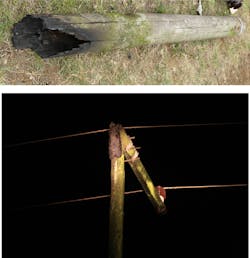The increased impedance of the wood-pole path that includes the air gap also improves bird safety, as the risk of birds being electrocuted is reduced. However, there is an increased risk the pole may burn at the air gap because of leakage current flow to earth. Field experience has shown the risk of burning in this position is significantly less than that of a wood cross arm burning.
For new overhead line construction, the use of composite phase insulators with at least a 31-mm/kV (1.22-inch/kV) specific creepage is recommended to limit the magnitude of leakage current. On existing lines, porcelain products with the same specific creepage specification may be acceptable for use as phase insulators.
All phase insulators must have suitable conductive end fittings to ensure leakage current is safely conducted from the surface of the insulators onto the bonding. Post insulators must be capped, and uncapped insulators need a leakage current collector plate to divert the leakage current to the bonding.
Steel cross arms may be used instead of wood cross arms, eliminating the problem with burning cross arms. Eskom uses steel cross arms extensively, but there are trade-offs with material and labor costs. Steel cross arms cost significantly more than wood cross arms, but they are also relatively simple to install and more robust. Steel cross arms also have issues related to vibration that causes nuts to loosen, steel-weld quality controls and corrosion mitigation. The utility has found steel cross arms achieve the same purpose with respect to pole-top fires as bonded wood cross arms, provided that all mitigation measures are correctly implemented.
Verifying Effectiveness
The effectiveness of these alternative mitigation measures can be verified in two ways: by investigating pole-top fires in the field and testing the measures in a highly polluted environment.
Eskom achieved the former through a targeted field investigation of structure fires. For all structures with pole-top fires in which the cause could be conclusively verified, the utility found those structures did not meet at least one of the mitigation criteria. For example, the overhead lines were constructed before bonding was introduced.
Eskom’s Koeberg Insulator Pollution Test Station (KIPTS) served as the high-pollution test environment, as it is located in a natural pollution environment close to the high-water mark of the Atlantic Ocean on South Africa’s West Coast, near Cape Town. This site was chosen for testing because of its severe pollution levels and the power and measurement infrastructure were already in place, as the test station was constructed specifically for insulator testing. Six wood-pole test structures were erected and each of the different insulator technologies and bonding arrangements were evaluated. The results of the tests verified the effectiveness of each of the proposed mitigation measures.
Other Wood-Pole Fires
Pole-top fires are generally restricted to overhead distribution lines and lower-voltage overhead transmission lines supported by wood poles. At higher voltages, capacitive rather than conductive effects dominate the performance of high-voltage overhead transmission lines.
Wood-pole structures installed to support overhead distribution lines are also subject to burning for reasons other than leakage current flow. For example, a phase conductor or jumper could get disconnected from its insulator and end up lying on the cross arm, a phase conductor or jumper could clash with a pole or stay in high wind, or a failed insulator could conduct excessive leakage current.
Lightning flashover occasionally causes a wood-pole structure to burn. If the structure is bonded and earthed correctly, then the fire would start on the pole at the insulation coordination gap (that is, at the location of flashover across the pole). However, the risk of poles burning in this way is lower than the risks mitigated by inclusion of the gap.
Each of these fires can be mitigated by addressing the cause, such as engineering designs where problems are encountered, ensuring overhead line hardware is adequately specified and scheduling maintenance inspections to detect loose conductor ties and brackets.
Engineering Philosophy
Many of the world’s overhead distribution line networks are routed in harsh environments, such as high levels of lightning or pollution. Measures can be introduced at the design stage, prior to construction, or retrospectively to improve the performance and safety of these distribution networks in high-pollution areas, where networks are more prone to pole-top fires. These fires are caused by leakage current flow produced by the light wetting of pollution deposited on phase insulators.







